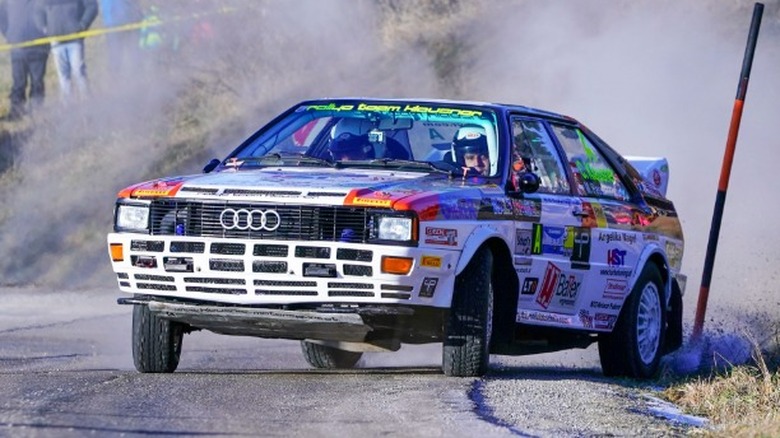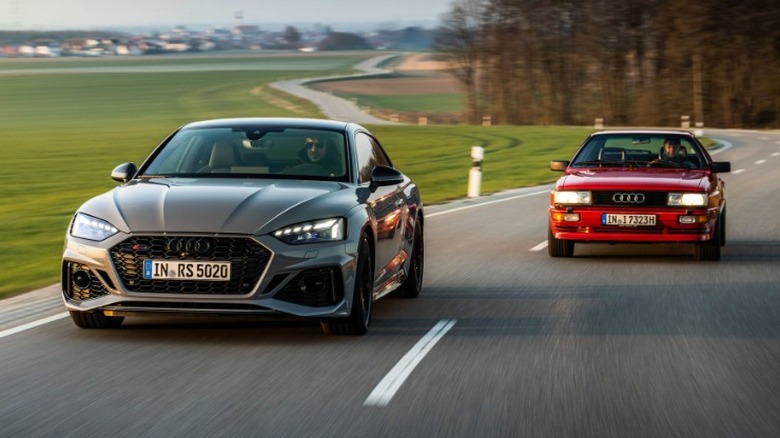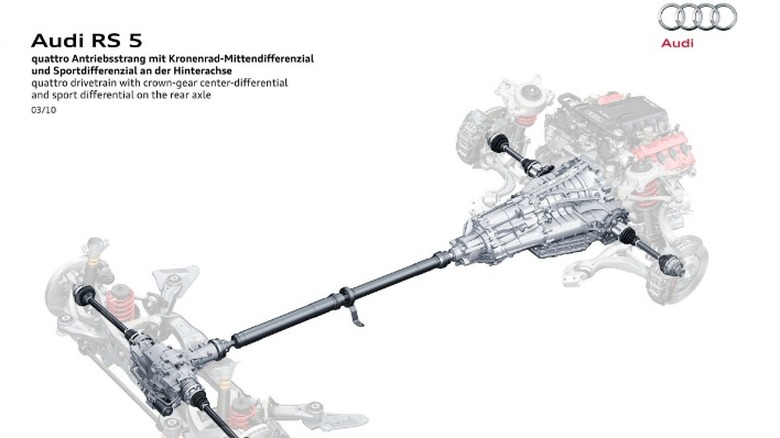Here's What Makes Audi's Legendary Quattro AWD System So Special
When it comes to sports cars, the conventional wisdom for a long time was that rear-wheel drive was the best way to put power down. RWD vehicles offer a better balance, give you more control through corners, and are generally more fun and rewarding to drive for experienced drivers.
That's why, despite the popularity of front-wheel drive, you'll still see many premium vehicles with a focus on performance putting power down through the rear wheels. Of course, front-wheel drive has its advantages too; being generally easier to get the hang of, offering better all-weather performance, and more efficient packaging.
While everyone was debating the merits of FWD and RWD, the automotive industry slowly warmed up to the idea of all-wheel drive. By the 1980s, AWD sports cars were exploding onto the scene, with the likes of the Porsche 959 and Audi "Ur" Quattro conquering the rally scene. It's no surprise that AWD is more popular than ever in performance vehicles.
Audi's Quattro AWD system in particular has gone through a number of iterations, and things have gotten more complicated. However, the original quattro system in the Audi Ur Quattro very closely resembled something you might find in a dedicated off-road vehicle.
Audi's quattro evolved through the ages to become electronically-enhanced
The first version of Audi's quattro featured three mechanical differentials — front, center, and rear — with the option to lock the center differential with a vacuum system. This resulted in a 50-50 torque split between the front and rear. In the 1980s, Audi replaced the center differential with a Torsen (or torque-sensing) differential, allowing torque to be directed to the wheel with traction instead of spinning the wheel without.
A regular open differential allows the wheels in an axle to spin at different rates, which is great if you need to make tight turns, but for situations where you don't have traction, it results in the wheel spinning aimlessly. To improve grip, Audi kept a rear locking differential when it added the Torsen to its quattro system. The change to a Torsen and rear locking differential meant that up to two thirds of torque could be sent to either axle when needed.
Audi really began to modernize its AWD system with the introduction of the transverse-engine Audi TT in the year 2000. The company switched out the Torsen center differential with a hydraulically-controlled, clutch-operated Haldex coupling, splitting power between the front and the rear.
This meant that the Audi TT was front-wheel-biased until it lost traction, distributing more of the torque to the rear axle to compensate. In addition, the TT also introduced EDL (electronic differential lock) that used the ABS system to distribute torque on a per-wheel basis.
Modern quattro systems are a bit more chaotic, but more capable
While there are a number of variations of quattro in modern Audis, the basic principle implemented after 2010 very closely resembles the system that made use of the Torsen differential back in the day — with a few differences depending on the platform.
Starting with Audi's medium and large cars (like sedans), quattro makes use of three differentials, with the center Torsen differential replaced by an in-house crown gear differential. This setup normally operates with 40% of the torque going to the front and 60% to the rear, but it can send up to 70% to the front and 85% to the rear.
Normally, electronic systems are deemed inferior to mechanical systems, but Audi's quattro system leverages both dependable, instant mechanical systems like the locking center differential, and advanced electronic systems like electronic brake distribution — all to deliver a smooth, trustworthy AWD experience.
Quattro uses a variety of techniques to enhance driving
In practice, the combination of electronic aids and locking mechanical differentials means that Audi's quattro system is one of the most capable AWD systems out there, even coming close to matching some dedicated off-road four-wheel drive systems.
As The Fast Lane Car on YouTube demonstrated using an Audi A6 Allroad with quattro, the AWD system allows a vehicle to free itself when all but one wheel have lost all traction. This is contrary to a more typical AWD system, or even a 4x4 system with open differentials that delivers torque to the wheels with the least traction, resulting in wasted power instead of increased grip.
Despite its rally roots and heavy focus on the mechanical systems, quattro is ultimately designed to enhance road driving during adverse weather conditions and rally driving. However, quattro uses a sport differential with technology like torque vectoring to enhance cornering, making the car both more stable and more agile by delivering more torque to the outside wheels. On smaller vehicles, with a transverse engine, quattro doesn't have a permanent 40-60 split, like the rest of the lineup. Instead, the system is front-wheel drive until a loss of grip occurs.
As the push for the electrification of the automotive space continues, Audi has continued to innovate its AWD system with what it calls e-tron quattro; making use of two electric motors in the rear and one in the front to distribute power across all wheels electronically.



